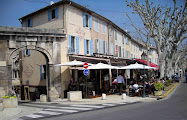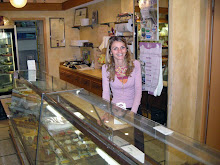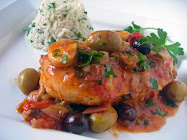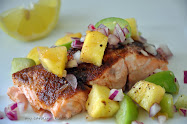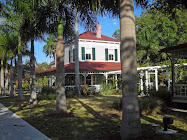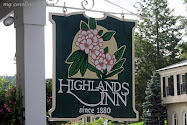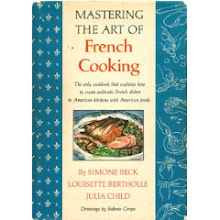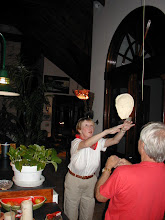Wednesday, August 31, 2011
Friday, August 26, 2011
A Visit to the Biltmore Estate, Gardens, & Kitchens in Asheville, NC
Biltmore Estate is a French Renaissance style chateau in Asheville, North Carolina and is referred to as “America’s largest home.” The estate sits on 8,000 acres and was built by George Vanderbilt at the height of the Gilded Age in the late 1800’s. Biltmore House is the largest privately-owned home in the United States and presents a detailed portrait of what life was like on a great 19th century grand country estate.
At the end of the 19th century, Asheville was a popular health resort where tourists arrived by train to enjoy the mineral springs and fresh air of the southern Appalachian mountains. One of those people was George Washington Vanderbilt, III, a member of one of the oldest, wealthiest, and best known families in America. He visited Asheville in 1888 as a bachelor with his mother and fell in love with the rugged beauty of the rural mountain setting. George traveled to Europe at age ten and visited Europe, Asia, and Africa numerous times during his adult life. But it was the mountains of western North Carolina that captured his heart.
Since no photos are allowed inside of the mansion, I hope you will enjoy our photos of the Biltmore’s grand Conservatory and the Walled Flower Gardens. Plants and flowers from the garden were important as decorations for the mansion and a special room was set aside in the basement for a floral design staff.
I’ll give you a little history of the building of the Biltmore and then, because this is a food site, some insight about how the Vanderbilt’s and their guest dined and what the kitchens were like.
 |
| Conservatory |
In the late 1800’s, land in Asheville was inexpensive and George Vanderbilt began purchasing large parcels, eventually owning 125,000 acres. Here he planned to build his estate, one where he would entertain his friends, but also be a showcase for his priceless collections of artwork and furnishing from around the world. He used the large baronies in Europe as an inspiration to build a profitable, self-sustaining estate to rival those of Europe.
To accomplish this monumental task, George hired two prominent Americans. One was architect Richard Morris Hunt, who was responsible for the main façade of the Metropolitan Museum of Art in New York and the pedestal for the Statue of Liberty. The other was Frederick Olmstead, known as the founding father of American landscape architecture. Olmstead designed New York’s Central Park and the grounds of the US Capitol. Together with George Vanderbilt, they designed the Biltmore Estate, a marvel of modern technology that rivaled the greatest manor homes in Europe with the finest architecture, landscaping, and interior design American had to offer.
The Biltmore House consists of 4 acres of floor space, 250 rooms, 33 family and guest rooms, 43 bathrooms, 65 fireplaces, 3 kitchens, a gymnasium, and an indoor swimming pool. It also had central heat, electricity, indoor plumbing, and fire alarms – and this was in 1895. The 125,000 acre grounds contained vast wooded forests, farms, a dairy, and horse stables for the estate, a 250 acre wooded park, 5 pleasure gardens, and 30 miles of rambling roadways.
The Vanderbilt’s entertained lavishly and guests would say for weeks at a time. It was the job of Edith, George’s wife, whom he met and married in Paris after he built Biltmore, to plan the activities of the day for their guests and work with the domestic staff for meal planning. Quite a job for a new bride wouldn’t you say.
 |
| George & Edith met and married in Paris |
Dinner was formal attire, served in Banquet Hall, the largest room in the mansion. Banquet Hall is 72’ x 42’ with a 70’ barrel-vaulted ceiling and has a long oak table that seats 32 with 2 gilt throne chairs for the hosts in front of a huge triple fireplace. Although massive, the room had perfect acoustics. Two people sitting at opposite ends of the dining table can converse without having to raise their voices. A small, more intimate table is also available in front of the fireplace in case the Vanderbilt’s happened to be dining alone. A smaller dining room off of Banquet Hall serves as a breakfast and luncheon room, where a 6-course lunch was served at one o’clock. The Vanderbilt’s dined on gold-rimmed Minton china, and drank from monogrammed French Baccarat crystal glasses.
As was the custom in country estates, the downstairs level, or basement, served three purposes. It contained the recreation areas, such a gymnasium and indoor swimming pool, that were used for the family and their guests. It also housed bedrooms and common rooms for the domestic staff. But it was also where the real work of the house took place and was designed to keep domestic chores out of sight and sound of the Vanderbilts and their guests.
You could compare the Biltmore’s kitchen complex to that of a large hotel and it was designed for maximum efficiency. There are numerous rooms devoted to pantries, including the housekeeper’s pantry, which doubled as storage and an office for the head housekeeper. As extraordinary as it sounds, there were walk-in food coolers at the end of the 19th century. A separate room was provided for a pastry kitchen to keep it away from the heat. A rotisserie kitchen where pheasant, duck, venison, and other animals brought back from shoot parties, were smoked in an iron rotisserie oven, fueled by wood or coal.
Most of the cooking took place in the spacious main kitchen, which was stocked with the latest culinary equipment available. Large numbers of chefs, cooks, and maids turned out everything from the Vanderbilt’s lavish dinners to a cup of tea for a thirsty guest. Meals prepared in the basement kitchens were transported to the first floor Banquet Hall’s butler’s pantry, where they were transferred onto serving dishes. The servants responsible for this chore were called “tweenies” because they brought food between the kitchen and the dining room. Warming carts were sent upstairs from the downstairs butler’s pantry, which had two dumb waiters, one manual and one electric. The butler’s pantry was also used to store and wash china.
I’ll share an interesting little story about the head chef with you. As I mentioned earlier, the basement also housed recreation areas for guests, including a two lane bowling alley, one of the first in a private home. The rear wall of the bowling alley backed up to the head chef’s quarters. If guests bowled late into the evening, the noise from the pins hitting wall of the chef’s room would keep him awake. During the tour we were told that if that happened, guests could expect a cranky chef the next morning at breakfast.
The basement also contained a servants’ dining room, two laundries, a drying and ironing room, and kitchen staff bedrooms. Other female maid’s rooms were on the fourth floor in the main house and the male domestic staff lived on the second floor of the stable and carriage house. Servants received breakfast, dinner, supper, mid-morning and mid-afternoon snacks daily, with dinner served at 12 noon. The head chef’s assistant prepared food for the servants and a dining-hall maid served their meals. The dining-hall maid was also responsible for keeping the room clean and maintaining all of the servant’s dishes and cutlery. Their meal typically consisted of a soup course, a meat course with vegetables, and dessert. The staff’s supper was around 5 or 5:30 pm, so they were available to prepare and serve the Vanderbilt’s meals later in the evening.
The Vanderbilt’s were gracious hosts and welcomed family and friends to the Biltmore where great attention was paid to each and every detail. We decided to experience what it was like to be a guest of George and Edith Vanderbilt and actually stay on the Estate. We celebrated my birthday by spending the night at the Inn on Biltmore Estate where we dined in luxury. In my next post I’ll have more about the Inn on Biltmore Estate and our dining experience.
I am linking this to Garden Tuesday at Sidewalk Shoes and Oh the Places I've Been at the Tablescaper. Be sure to drop by and see what's growing in gardens this time of the year.
Tuesday, August 23, 2011
Purple French Heirloom Beans
Did you know that haircots verts, or little French green beans, come in purple? I didn’t until I found some heirloom French beans at our Farmer’s Market last weekend. The lady I bought them from told me that they have the same texture and taste as a haircots verts except they are purple. They are renowned for tenderness and flavor and their color stands out on the vine.
This is one of those times when I should have done my homework before I attempted to cook something new. I didn’t realize that, like many other purple vegetables, their purple color is only skin deep and will change to green when cooked. You can imagine my surprise when their purple color disappeared as they began to cook. If you want to retain their beautiful color, it is recommended that you serve them raw as part of a vegetable tray.
Nonetheless, this light French bean salad turned out to be a very simple and delicious dish garnished with yellow heirloom pear-shaped tomatoes from our garden and a few red grape tomatoes thrown in for contrast. Heirloom yellow pear-shaped tomatoes are low in acid, delightfully sweet, and are often referred to as “garden candy.”
Green Bean Salad Dressed with a French Vinaigrette
From My Carolina Kitchen
For thin beans and haircots verts Julia Child’s method of cooking is tried and true and never fails me. Julia snaps the ends off the green beans and then plunges them into a large pot of rapidly boiling salted water. Bring the water back to a boil as fast as possible and boil slowly for a few minutes until the bean are tender. Do not walk away while they’re cooking. I taste and test, test, test as I go so I don’t over-cook them. You want a little crunch in the bean. (Julia did not like undercooked vegetables and neither do I.) Their taste should change from raw to sweet and tender when they’re done. Slender haircots verts may take only 3 or 4 minutes to cook. Regular green beans are done in about 6-7 minutes. The secret here, according to Julia, is to use a large amount of water so it will come quickly back to a boil, thus setting the color.
If you are not serving the beans right away, when they’re done plunge them in an ice water bath to retain their color, then drain well.
I dressed my beans with a French vinaigrette and garnished them with grape tomato halves, a little chopped red onion, and slivers of fresh basil. Bon Appétit as Julia would say.
 |
| Purple French Heirloom Beans |
French Vinaigrette – enough for 4 servings
From My Carolina Kitchen
1 tablespoon freshly squeezed lemon juice (or red wine vinegar)
3 tablespoons extra-virgin olive oil
½ teaspoon Dijon mustard
Fine sea salt and freshly ground black pepper to taste
Place all of the ingredients in a jar with a screw-top lid and shake well. This will keep in the refrigerator for about a week. Excellent on mixed green salads.
I am linking this to Garden Tuesday and Fresh Food Friday. Slip on over and see what's growing in other gardens on Sidewalk Shoes and all of the great food featured on La Bella Vita..
Friday, August 19, 2011
Summer Corn and Tomato Salad –A Simple Summer Side Dish
Sometimes I think side dishes are the hardest for me when it comes to menu planning. I can always come up with the main course, but side dishes seem to fry my brain.
This little corn and tomato salad, augmented with sweet red bell peppers and fresh basil, is the essence of summer and so easy to put together. The hard part is finding really, really fresh corn and vine ripe tomatoes. Fortunately it is just the right time of the year for them here in the states.
I’ve served this as a side dish to grilled steak, but it would also be good with grilled pork tenderloin or chicken. Enjoy fresh corn and tomatoes while you can. Summer is slipping away.
Fresh Corn and Tomato Salad
From My Carolina Kitchen
2 cups fresh corn kernels, about 4 ears
½ cup chopped red bell pepper
1 cup grape tomatoes halves
1 tablespoon extra-virgin olive oil, plus a little more for cooking
2 tablespoons good Spanish sherry vinegar
3 – 4 tablespoons chopped fresh basil
Kosher salt and freshly ground black pepper to taste
Tiny fresh thyme leaves for garnish
Add a couple of dashes of extra-virgin olive oil to a large non-stick skillet and heat over medium-high heat on the stove. Add the corn and bell pepper and sauté about 4 – 5 minutes, until lightly browned. Don’t overcook. You want them to retain their crunch. Remove from the heat and put in a large bowl. Add remaining ingredients except thyme leaves and stir. Garnish with fresh thyme. Serves 4.
I am linking this to:
La Bella Vita’s Fresh Food Friday
Foodie Friday at Designs by Gollum
On the Menu Monday at Stone Gable
So take your appetite on over and have a look. You’re guaranteed to come away hungry, and don’t say I didn’t warn you.
Tuesday, August 16, 2011
The Original Pasta Primavera Recipe – Created By Ed Giobbi
An interesting story surrounds the origin of pasta primavera. Ed Giobbi, in his cookbook Eat Right, Eat Well – The Italian Way says, “I feel that something should be said about “pasta primavera,” perhaps the most popular pasta recipe in America today and certainly the most misunderstood. I would like to emphasize that the pasta primavera that is so popular in American today is not of Italian origin, but was created in Le Cirque restaurant.”
One of Ed’s claims to fame is that he invented the now well-know dish pasta primavera. Ed tells the story that in 1973 his good friends Chef Jean Vernges and restaurateur Sirio Maccioni visited his home to see if he would contribute a pasta recipe for their new restaurant, Le Cirque, in New York City. He put together a favorite pasta dish of his, “Pasta Primavera,” which was then unknown in New York City. It was a beautifully simple dish of unrefrigerated garden-ripe tomatoes cut into cubes, freshly chopped fresh basil and Italian parsley, very good olive oil, finely chopped garlic, salt, and freshly ground black pepper. and served it over spaghettini.
It turns out that the simple spaghetti dish with garden-ripe tomatoes that Ed whipped up that day for his friends was the forerunner of one of the most popular dishes in America – Pasta Primavera.
When New York’s Le Cirque opened in 1976 and popularized pasta primavera, Craig Claiborne & Pierre Franey called it “by far the most talked-about dish in Manhattan.” However, at least two other people other than Ed Giobbi have laid claim to its creation. In his memoir, Le Cirque’s owner Sirio Maccioni gave credit to his wife, and Chef Jean Vergnes, who doctored Giobbi’s version with cream and vegetables for the 4 star restaurant. It’s interesting to note that despite Chef Vergnes’ claim of inventing pasta primavera, he was said to hate it so much that he forced his cooks to make it in the restaurant’s hallway. Here is Le Cirque’s pasta primavera recipe, including all 10, as the New York Times calls them, pain-in-the-neck steps.
I have made Ed Giobbi’s original simple pasta primavera using three different colored vine ripe, locally grown heirloom tomatoes. & homegrown if you have them. In his cookbook Ed gives three recipes for pasta primavera. In one he recommends blending the tomatoes in a food processor so the spaghetti will be easier to twirl with your fork and at the same time pick up some of the tomatoes and basil. If you want to make it easier to eat, use any ordinary garden fresh tomatoes instead of the heirlooms. In my opinion whirling precious heirloom tomatoes in a food processor would be akin to putting a Chanel suit in the washing machine.
Ed Giobbi’s Pasta Primavera with Heirloom Tomatoes
Adapted from Eat Right, Eat Well – The Italian Way by Edward Giobbi –Serves 2, easily doubled - use homegrown tomatoes if you have them
½ pound thin spaghetti
Kosher salt for the pasta water
1-1/2 to 2 cups fresh garden-ripe heirloom tomatoes, at room temperature
2 small cloves of garlic, finely chopped
2 tablespoons extra-virgin olive oil
4 tablespoons slivered fresh basil, plus a few small leaves for garnish
2 tablespoons chopped fresh Italian flat-leaf parsley
Fleur de Sel (French sea salt) or any good fine grain sea salt
Freshly ground black pepper to taste
Boil pasta in salted water, following package directions.
In the meantime, cut the tomatoes into slices parallel to the stem and discard the stem. Cut the tomato slices into ½” cubes and place in a colander to drain. About 2 to 3 minutes before the pasta is done, place the drained tomatoes in a large bowl with the remainder of the ingredients and stir very gently. Be sure to treat the heirloom tomatoes with care. They tend to bruise easily.
When pasta is cooked al dente, drain well by shaking the pasta in a colander so that all of the water drains off. In a large bowl, toss the hot spaghetti with the raw tomato sauce and serve immediately. Pass additional Fleur de Sel and freshly ground black pepper at the table.
Cooks note: Only make this when tomatoes are at their peak of freshness.
I am linking this to
Fresh Food Friday at La Bella Vita
Foodie Friday at Designs by Gollum
On the Menu Monday at Stone Gable
Drop by and sample all of the goodies. You won't be dissappointed.
Wednesday, August 10, 2011
Gazpacho Soup Plus Some Variations
Cold gazpacho soup makes a light and refreshing lunch on these sultry summer days when you’re craving something healthy and don’t want to heat up your kitchen. If you’ve been reading My Carolina Kitchen for a while, you may remember the gazpacho soup that I prepared for a guest appearance on Lazaro Cooks a while back. I decided to do a re-run of it plus some variations because it’s one of our very favorite soups and it deserves its own place here at home in my stable of recipes.
Did you know tomatoes haven't always been in gazpacho soup? Gazpacho is an ancient soup, believed to have originated with the Arabs, and comprised of only bread, olive oil, water, and garlic. Later the Romans added vinegar. Even though Cortez brought the tomato to Spain in the 16th century, it wasn’t added to the recipe until the 1700s. At the time, the tomato was believed to be poisonous and consequently only grown as a decorative plant. A famine in Italy 200 years later caused starving peasants to eat the tomatoes with no ill effect and the rest, as they say, is history.
From time to time I’ve played around with the basic ingredients in gazpacho, used different vinegars - sherry, rice, balsamic, or combinations, purchased different colored bell peppers, substituted V-8 for the tomato juice, added a fresh jalapeno for heat, and used homemade croutons as a garnish.
I also happen to get bored easily and am always on the look-out for new twists on old favorites. I’ve seen three other gazpacho recipes that sound intriguing: one with pineapple as a base, one with watermelon, and one with mango, which I’ll show you below. But first, here’s a classic chunky gazpacho with a couple of different garnishes that’s our family favorite.
Classic Chunky Gazpacho – Basic Recipe
Adapted from “At Blanchard’s Table” – serves 8
8 plum tomatoes (or 4 large heirloom or beefsteak tomatoes), core removed & cut
into quarters
1 large red bell pepper, seeded & cut into quarters
1 medium seedless cucumber, peeled and cut into chunks
4 tablespoons red wine vinegar
1 ½ tablespoons freshly squeezed lemon juice
4 tablespoons extra-virgin olive oil
1 ½ cups tomato juice
Pinch of cayenne pepper
1 teaspoon Kosher or sea salt
½ teaspoon freshly ground black pepper
4 tablespoons chopped fresh dill
2 tablespoons minced red onion
Place the tomatoes into a food processor and pulse until very coarsely chopped but not pureed. Remove from the bowl, and repeat with the pepper & cucumber.
In a large bowl, whisk together the vinegar, lemon juice, oil, and tomato juice. Add the cayenne, salt, pepper and chopped dill to the vinegar mixture. Add the chopped vegetables and minced onion and mix well. Chill and serve cold.
For the seafood theme seen above
Prepare the basic recipe for gazpacho. Serve very cold, garnished with fresh lump crab meat.
For a tropical twist as a garnish
Prepare the basic recipe for gazpacho. Serve very cold, garnished with chopped mango and a sprig of fresh dill.
Mango Gazpacho
Adapted from "Perfect Recipes for Having People Over" by Pam Anderson
2 cups of small diced fresh mango, peeled and seed discarded
2 tablespoons extra-virgin olive oil
1 small seedless cucumber, peeled and cut into small dice (about 2 cups)
1 small red bell pepper, cored, seeded, and cut into small dice (about ¾ cup)
1 small onion, cut into small dice (about ½ cup)
2 medium garlic cloves, minced
1 small jalapeno pepper, seeded and minced (optional, but recommended)
2 cups orange juice, preferably freshly squeezed
3 tablespoons freshly squeezed lime juice
3 - 4 tablespoons chopped fresh basil (or cilantro or parsley)
Combine all ingredients in a large bowl. Stir well and chill. Serve cold. Garnish if desired with grilled wild-caught shrimp that have been seasoned before grilling with sea salt, freshly ground black pepper, and sweet smoked Spanish paprika, also known as Pimenton de la Vera.
The two variations below are also from Perfect Recipes for Having People Over by Pam Anderson
Pineapple Gazpacho
Substitute pineapple for the mango and pineapple juice for the orange juice in the Mango Gazpacho recipe above.
Watermelon Gazpacho
Substitute small diced seeded watermelon for the mangos and use a yellow bell pepper for the red one in the Mango Gazpacho recipe above.
Printable recipe for basic gazpacho & variations
Tasting note: Although the mango gazpacho was very refreshing and the multi-colors of the various ingredients looked spectacular in the bowl, the tomato based gazpacho will always be our favorite. In fact when I asked my husband the question I always ask when we try a new recipe, “Would you have this again?” he said no. When I asked why, his answer was, “I just don’t like it.” I’m curious. Have you ever made gazpacho with unusual ingredients and what did you think of the results?
I am linking this to:
On the Menu Monday at Stone Gable
La Bella Vita’s Fresh Food Friday
Foodie Friday at Designs by Gollum
So take your appetite on over and have a look. You’re guaranteed to come away hungry, and don’t say I didn’t warn you.
Friday, August 5, 2011
Grilled Thai Barbecued Chicken - Just in Time for Summer Cookouts
This grilled barbecued chicken is a bit unusual in that it's marinated in coconut milk and nam pla, an Asian fish sauce. Nam pla is one of the basic ingredients in Thai cooking and can be found in the Asian section in most supermarkets. It’s made from a mixture of fish, anchovies, salt, and sometimes sugar that’s been allowed to ferment for up to eighteen months. Read the label to be sure it doesn’t contain any MSG. Because fish sauce is fermented, it doesn’t require refrigeration and will keep almost indefinitely on your shelf. Good fish sauce should resemble the color of Scotch whisky and does not taste or smell too fishy.
The lime juice gives the chicken nice, fresh zing, and the hot sauce and red pepper flakes add a bit of spice. Be sure to serve lime wedges on the side so diners can squeeze a little extra juice over their chicken.
For an unusual appetizer, substitute chicken wings and drumettes for the chicken parts and pass on a platter with extra napkins.
Give this Thai BBQ chicken a try at your next cookout. It’s definitely not your Daddy’s BBQ chicken.
Grilled Thai Barbecued Chicken
Adapted slightly from The Beach House Cookbook
1 cup coconut milk (I used the light version)
1/2 cup nam pla (Asian fish sauce)
1/4 cup freshly squeezed lime juice
4 small cloves garlic, peeled and minced
2 shallots, peeled and minced
1 teaspoon hot sauce, such as Tabasco
1 teaspoon red pepper flakes
1 1/2 tablespoons sugar
1/2 cup chopped fresh cilantro
Kosher salt and freshly ground black pepper to taste
1 chicken, preferably organic (about 2 1/2 to 3 pounds), cut into serving pieces
6 scallions, trimmed and minced, for garnish or Thai basil
1 fresh lime, cut in wedges for garnish
Combine the coconut milk, nam pla, lime juice, garlic, shallots, hot sauce, red pepper flakes, sugar, and cilantro in a blender or food processor and blend until smooth. Salt and pepper both sides of the chicken and put it in a large plastic zip lock bag. Pour the coconut mixture over the chicken and marinate it for 4 hours in the refrigerator, turning the chicken occasionally.
Prepare a gas or charcoal grill. When the fire is medium-hot, and the coals are covered with a light coating of ash and glow deep red, remove the chicken from the bag, and discard the marinade. Put the chicken on the grill, bone side down. Cover and cook for about 15 minutes. Turn the chicken and cook, skin side down, covered, until the juices run clear, about 12 to 15 minutes, or until the internal temperature is 160 degrees. Transfer the chicken to a platter and garnish with the scallions or Thai basil. Serve at once with lime wedges on the side. Serves 6.
I'll be linking this to Food on Friday at Carole's Chatter.
Tuesday, August 2, 2011
An Easy Italian Appetizer - Savory Cantaloupe Salad
I just returned home from shopping in our picturesque little village in the hills of Lombardy. In my straw market bag I had a juicy melon so ripe I could smell it before I saw it. Also in my bag was a spicy soppressata salami, some creamy fresh goat cheese, and country bread, freshly baked by my neighbor Claudio.
Late in the afternoon as the sun began to set over the hills, I went into the kitchen of my villa and put together a little antipasto salad. I took the sweet, fragrant melon and cut it into bite size pieces, seasoned it with a pinch of sea salt and a few generous grinds of fresh black pepper, gave it a quick stir, and had a taste. Si, perfetto. I added a little olive oil, tossed the melon gently again, and then finished the salad with a splash of white wine vinegar.
In my little garden off of the terrace, I picked a few sprigs of fresh chives, returned to the kitchen, and used my scissors to snip them over the top off the salad. For a final garnish, I cut the salami into thin strips, and sprinkled them over the melon. To complete the antipasto plate, I spread fresh goat cheese on toasted slices of the country bread to serve alongside the melon salad. Now all I need to do is find that bottle of vino I’ve been saving for company.
When I awoke from my dream, I found myself at home in my small town in the Blue Ridge Mountains of North Carolina, craving the little Italian savory antipasto melon salad from my dream. I looked down and in my lap was a copy of an old Food & Wine magazine. It was open to an article titled Instant Italy written by Lynne Rossetto Kasper and a recipe for savory cantaloupe salad.
For an appetizer that evening, I put together a melon salad in a similar manner as described above. I substituted freshly squeezed lime juice for the vinegar and slivers of summer sausage for the Italian soppressata salami called for in the original recipe because soppressata was not readily available. The salad was in one word – fantastico.The black pepper and lime juice together bring out the sweetness of the melon and the spicy salami gives the salad just the right amount of bite to it.
Next time I think I’ll go the extra mile and seek out authentic Italian soppressata salami instead of settling for supermarket summer sausage. But I have to say that if you can’t find soppressata, the summer sausage was a more than worthy substitute. I have since served the salad using fresh Italian basil in place of the chives and it was fabulous also.
Some opera music playing in the background would be perfect when you serve this appetizer. The Lombardy region of Italy is the birthplace of composer Guiseppe Verdi, one of the most famous and influential opera composers of the 19th century. A little La Traviata anyone?
Cantaloupe – it’s not just for breakfast anymore.
I will be linking this to
On the Menu Monday at Stone Gable
Subscribe to:
Posts (Atom)

































